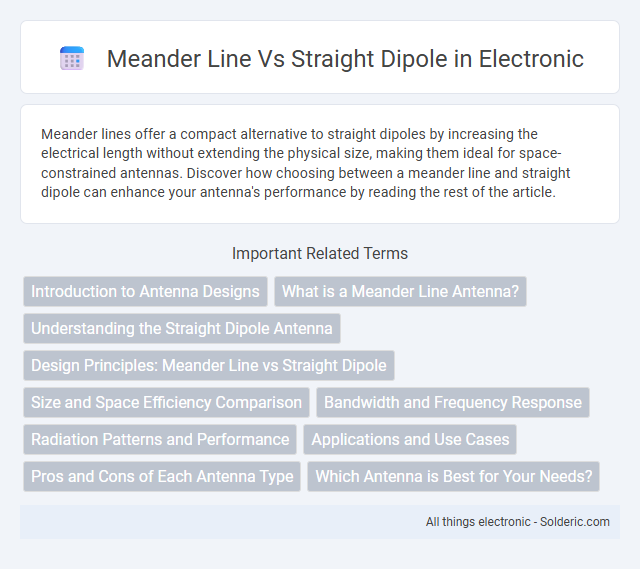Meander lines offer a compact alternative to straight dipoles by increasing the electrical length without extending the physical size, making them ideal for space-constrained antennas. Discover how choosing between a meander line and straight dipole can enhance your antenna's performance by reading the rest of the article.
Comparison Table
| Feature | Meander Line Antenna | Straight Dipole Antenna |
|---|---|---|
| Design | Folded, zigzag or serpentine shape | Simple, straight conductor |
| Size | Compact, shorter physical length for given frequency | Longer length, half wavelength |
| Resonant Frequency | Lower due to increased electrical length | Fixed by physical half wavelength |
| Bandwidth | Narrower bandwidth | Wider bandwidth |
| Radiation Efficiency | Lower, due to increased losses | Higher efficiency |
| Application | Compact devices, limited space | General purpose antennas, wideband applications |
| Impedance | Typically higher, depends on meander pattern | Near 73 ohms (free space) |
Introduction to Antenna Designs
Meander line antennas use a serpentine conductive path to reduce the overall antenna size while maintaining effective electrical length, making them suitable for compact wireless devices. Straight dipole antennas consist of two straight conductive elements of equal length, providing a simple, resonant design with predictable radiation patterns and impedance characteristics. The choice between meander line and straight dipole antennas depends on space constraints and performance requirements in RF communication systems.
What is a Meander Line Antenna?
A Meander Line Antenna is a type of antenna where the conductive path is folded back and forth in a zigzag or serpentine pattern to reduce the overall physical length while maintaining the electrical length. Compared to a Straight Dipole Antenna, the Meander Line Antenna offers a more compact form factor, making it ideal for space-constrained applications without significantly compromising performance. This antenna design is commonly used in portable devices and embedded systems where antenna size reduction is crucial.
Understanding the Straight Dipole Antenna
The straight dipole antenna is a fundamental radio antenna consisting of two equal-length conductive elements aligned end-to-end, optimized for resonant frequency operation to ensure efficient transmission and reception. Its simple geometry results in a predictable radiation pattern, typically a figure-eight in the horizontal plane, providing broadside maximum signal strength. Compared to meander line antennas, straight dipoles offer lower loss and higher efficiency but require more physical space due to their resonant length constraints.
Design Principles: Meander Line vs Straight Dipole
Meander line antennas achieve compactness by folding the conductor into a serpentine shape, increasing electrical length within a smaller physical footprint compared to the straight dipole's linear design. This design principle allows meander line antennas to maintain resonance at lower frequencies without requiring the full half-wavelength length typical of straight dipoles. Your antenna choice depends on space constraints and frequency requirements, with meander lines optimized for limited space applications while straight dipoles provide simpler design and predictable radiation patterns.
Size and Space Efficiency Comparison
Meander line antennas significantly reduce the overall length compared to straight dipoles by folding the conductor into a compact, serpentine shape, making them ideal for space-constrained applications. Straight dipoles require a length close to half the wavelength, limiting their use where size is a critical factor. Meander line designs optimize antenna footprint while maintaining resonant frequency, offering enhanced space efficiency without substantial performance loss.
Bandwidth and Frequency Response
Meander line antennas provide a compact design with a narrower bandwidth compared to straight dipole antennas, which offer broader frequency response and improved bandwidth performance. The meandering pattern introduces additional inductance and capacitance, causing a reduced bandwidth but enabling size reduction for space-constrained applications. Your choice depends on whether you prioritize size conservation with limited bandwidth or broader frequency response with a standard straight dipole.
Radiation Patterns and Performance
Meander line antennas exhibit more compact sizes with increased inductance, causing slight distortion in radiation patterns compared to straight dipole antennas, which maintain a more uniform and predictable pattern. The meander line's closely spaced segments induce mutual coupling, resulting in lower gain and narrower bandwidth, while straight dipoles offer higher efficiency and broader bandwidth due to their linear geometry. Performance-wise, straight dipoles deliver stronger signal strength and better overall radiation efficiency, whereas meander lines are preferred for space-constrained applications despite some compromise in pattern purity and gain.
Applications and Use Cases
Meander line antennas are ideal for compact devices where space constraints exist, such as wearable technology, mobile communications, and RFID systems, because they offer a reduced physical size while maintaining resonance at lower frequencies. Straight dipole antennas are commonly used in broadcasting, amateur radio, and point-to-point communication due to their simple design, ease of construction, and efficient radiation patterns. Your choice between a meander line and straight dipole depends on whether you prioritize miniaturization or performance in open environments.
Pros and Cons of Each Antenna Type
Meander line antennas offer compact size and better integration in limited spaces but suffer from lower efficiency and narrower bandwidth compared to straight dipoles. Straight dipole antennas provide higher radiation efficiency and broader bandwidth, making them suitable for clearer signal transmission but require more physical space. Your choice depends on the trade-off between size constraints and performance needs in a specific application.
Which Antenna is Best for Your Needs?
Meander line antennas compact the design by folding the element, making them ideal for applications requiring smaller size and limited space, though with slightly reduced efficiency and narrower bandwidth compared to straight dipoles. Straight dipole antennas offer better performance in terms of gain and bandwidth, suited for applications where size is less constrained and optimal signal strength is critical. The best choice depends on balancing size constraints, bandwidth needs, and efficiency requirements specific to the intended use case.
meander line vs straight dipole Infographic

 solderic.com
solderic.com